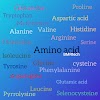DNA(Deoxyribonucleic Acid)
It is a molecule composed of two polynucleotide chains that coil around each other to form a double helix, carrying genetic instructions for the development, functioning, growth and reproduction of all organisms and many viruses.
or
DNA is a self replicating material which is present in nearly all living organisms as the main constituents of chromosomes. It is the carrier of genetic information.
or
It is the hereditary material in humans and almost all other organisms. Nearly every cell in a person's body has the same DNA.
The two DNA strand are know as polynucleotides as they are composed of simpler monomeric units called nucleotide. Each nucleotide is composed of one of four nitrogen containing nucleobases (cytosine C, guanine G, adenine A, thymine T) a sugar called the deoxyribose, and a phosphate group. The nucleotides are joined to one another in a chain by covalent bonds(also know as phospho-diester linkage). A strand binds to T with double bond (A=T) and G strand binds to C with triple bond (G=C). Both strands of double-stranded DNA store the same biological information. The two strands of DNA run in opposite directions to each other and are thus antiparallel (3' to 5' direction and 5' to 3' direction). RNA strands are created using DNA strands as a template in a process called transcription, where DNA bases are exchanged for their corresponding bases except in the case of thymine (T), for which RNA substitutes uracil (U). Under the genetic code, these RNA strands specify the sequence of amino acid within proteins in a process called translation.
HISTORY :-
1) Johannes Friedrich Miescher
DNA was first isolated by Friedrich Miescher in 1869. Miescher isolated various phosphate-rich chemicals, which he called nuclein (now nucleic acids), from the nuclei of white blood cells in 1869 in Felix Hoppe-Seyler's laboratory at the University of Tubingen, Germany, paving the way for the identification of DNA as the carrier of inheritance. He was the first scientist to isolate nucleic acid.
2) Rosalind Elsie Franklin :-
Rosalind Elsie FranklinRosalind Elsie Franklin (25 July 1920 – 16 April 1958) was an English chemist and X-ray crystallographer whose work was central to the understanding of the molecular structures of DNA (deoxyribonucleic acid), RNA (ribonucleic acid), viruses, coal, and graphite.
X-Ray Crystallography
3) Francis Crick and James Watson
Francis Crick and James WatsonLate in 1951, Francis Crick started working with James Watson at the Cavendish laboratory within the University of Cambridge In February 1953, Linus Pauling and Robert Corey proposed a model for nucleic acids containing three intertwined chains, with the phosphates near the axis, and the bases on the outside.
PROPERTIES :-
- Nucleobase Classification
- Non-canonical bases
- Listing of non-canonical bases found in DNA
- Grooves
- Base pairing
- Sense and Antisense
- Supercoiling
- Alternative DNA structure
- Alternative DNA chemistry
- Quadruplex structures
- Branched DNA
- Artificial bases










2 Comments
Nice information ... Thanx for the efforts as well ...
ReplyDeleteThank you for your comment....you need more information any subject.....comment me....we help you......
Delete